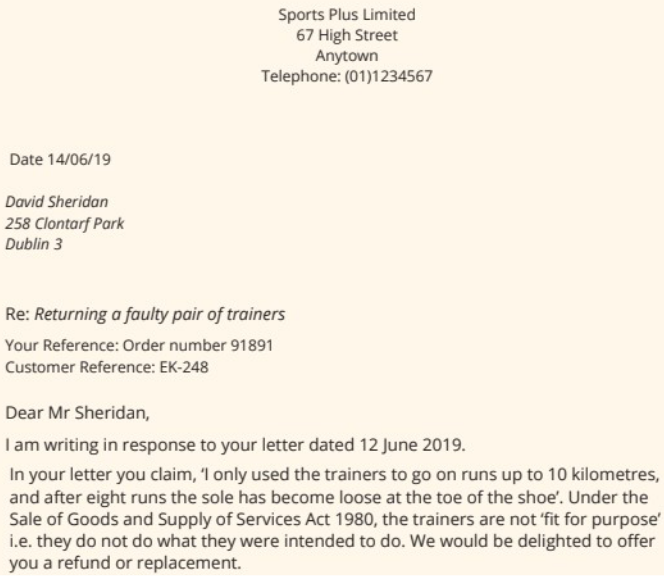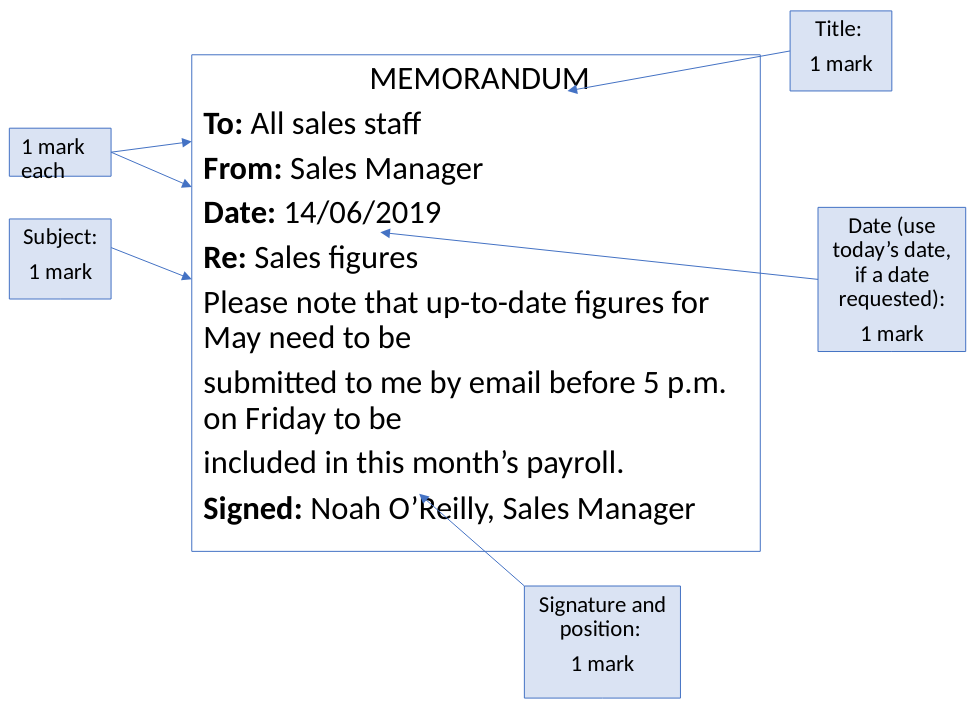7. Management Skills: Communicating
Learning Outcomes from this chapter
- Explain the central role of communications in business and management
- Distinguish between the methods of communication
- Discuss the importance of general communication skills
- Identify and explain the main barriers to effective communications
- Demonstrate business data in written forms, including business letters, reports and memos
- Draft a visual presentation from data
- Identify the duties of a chairperson and secretary, and draft an agenda and minutes of a meeting
- Illustrate the impact on business due to changes in ICT
- Understand what ‘GDPR’ is and the role of the Data Protection Commission in data protection in Ireland
Communication
Communication is the transferring of information from the sender to the receiver through a medium
Internal communication
This is the transfer of information between staff in a workplace
External communication
This the transfer of information from the business to its stakeholders.Stakeholders include: investors, suppliers, interest groups, customers, government and society
Elements that help make communication effective
| Term | Definition |
|---|---|
| The Right Duration | No overload |
| Accurate Message | Clear and structured with expected outcomes |
| Language | Appropriate terms/jargon to ensure message is understood |
| Visual Aids | Clear charts, graphs and summaries |
| Confidentiality | Ensure any sensitive information is secure |
| Feedback | Allow/encourage feedback |
| Timing | Instant interaction for urgency |
| A Record | Easily retrievable messages containing data, details, etc. |
How effective communications can help a business
- Improved employee morale
- Improved accuracy
- Better decisions
- Quicker decision-making
- Lower staff turnover
Removing barriers to effective communication with stakeholders
| Term | Definition |
|---|---|
| Noise | Choose a quiet setting |
| Lack of Clarity | Ensure the message is clear; use professionals |
| Lack of Accuracy | Upskill staff |
| Language | Adapt the language to suit the recipient |
| Timing | Use face-to-face for urgency |
| Wrong Medium | Host confidential meetings where necessary |
| Information Overload | Give clear and concise instructions |
| Technology | Invest to upgrade systems and apps |
Elements of a business letter
- Letterhead (company name, address, contact)
- Reference (customer no./order no.)
- Date: Use today’s date, if asked
- Subject (Re:)
- Introduction
- Main body
- Conclusion
- Salutation: ‘Yours sincerely’ (if you know their name) OR ‘Yours faithfully’ (if you don’t know their name)

Important elements of a report
- Report title
- Prepared by
- Prepared for
- Date
- Terms of reference
- Main findings
- Recommendation/conclusion
- Signature/job title

What a memo looks like and what is needed
In the 2009 exam, 6 out of 10 marks were for layout of the memo

Types of Business Meetings
| Term | Definition |
|---|---|
| Annual General Meeting (AGM) | Mandatory yearly gathering of shareholders |
| Extraordinary General Meeting (EGM) | Urgent gathering of shareholders to vote |
| Board meeting | Monthly meeting of board of directors |
| Ad hoc meeting | Unplanned meeting for issues that arise suddenly |
| General meeting | Regular meetings (e.g. staff meetings) |
Duties of the secretary and chairperson
Secretary
- Sends notice and agenda to all who should attend
- Arranges venue, facilities, ICT, etc.
- Deals with correspondence
- Records the minutes and types them up after the meeting
- Aids the chairperson in the smooth running of the meeting
Chairperson
- Sets the agenda for the meeting
- Ensures a quorum (minimum no. of attendees needed to start)
- Reads/adopts minutes of previous meeting
- Manages the meeting (timing, fair speaking time for all attendees)
- Calls for votes and has the casting vote in the event of a tie
Notice and agenda for a meeting
Notice - Sent out to everyone due to attend a meeting; outlines what the meeting is, who it is for, where it will be, and when it will start/end
Agenda - Business meeting: Review of previous meeting’s minutes, chairperson’s report, auditor’s report, declaration of dividends, election of directors, and any other business (AOB) Club meeting: Review of previous meeting’s minutes, chairperson report, secretary’s report, treasurer’s update, sub fees for next year, elections, and any other business (AOB)
The developments of ICT and its impact on business
| Term | Definition |
|---|---|
| Cloud Storage | Internet security needed |
| E-commerce | Over-reliance on internet |
| Networking | Resources into non-sales |
| Videoconferencing | Saves time and travel costs |
| Cyber crime | Hackers/disruption |
| Regulations | GDPR compliance costs |
| Apps/Websites | Investment required |
| CAD | Harder to control spread of designs |
General Data Protection Regulation (GDPR)
| Term | Definition |
|---|---|
| Business Responsibilities | Use for specified purpose, keep data secure, obtain fairly, provide copy |
| Individual rights | Copy in 30 days, can have data erased/corrected, can obtain info on processing |
| Data Protection Commission (DPC) | National independent body to uphold personal data rights |
| Implications of GDPR | Higher standards, transparency, data breach fines, compensation |